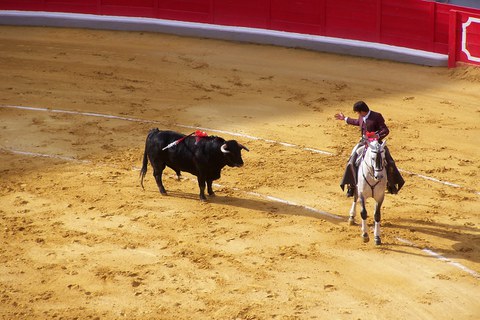Apr 28, 2023
Animals and Money: Fighting Bulls in Madrid – Money Maker or Subsidized Animal Cruelty?

Bullfighting is an old tradition in Spain, but controversially discussed. What role does it play for the economy in Madrid?
Bullfighting has been deeply rooted in Spanish history for centuries and is a tradition maintained to this day. Due to a law passed in Spain in 2013, bullfighting is considered as national cultural heritage and is therefore legally preserved1. In the following, the economic importance of fighting bulls will be estimated for the main important area for bullfights, which is Madrid, hosting the most relevant bullfighting arena in Spain, the so called “Plaza de Toros de las Ventas”2 .
Bullfights are complex and several fighting subtypes exist that slightly differ in their structure, for example in the age of the bull, or whether the bullfight is performed on horseback or on foot. In every bullfight three “Toreros”, working with five assistants respectively, perform a choreographed fight against two bulls each. In total there are six separate fights, that all last about 20 minutes and a total of six bulls are killed. The assistants weaken the bull by sticking lances and barbed sticks into the muscles in the neck of the bull, forcing it to lower its head. Finally, this weakened position enables the Torero to kill the bull by sticking the sword into its neck. Sometimes the bull does not die instantly and a second attempt is necessary3, 4 . These practices make bullfighting an extremely controversial topic, due to animal welfare concerns5.
In 2019, Madrid hosted a total of 71 bullfighting events, which attracted roughly 946.000 spectators6. 699.000 of these tickets were sold for roughly 6 -160 € in 2019, remaining 247.000 visitors of the two less popular types of bullfighting, payed between 3 –90€7. Overall, the 71 events hosted in Las Ventas in Madrid could have generated between 4,9 mio - 134 mio € in sold tickets, calculated with lowest and highest priced tickets, respectively. The arena in Madrid can also be visited, with prices ranging from 6 € to 70 €8. According to the organizers, the tours attracted 102.500 visitors in 20199, thereby generating an estimated 615.000 - 7,2 mio €.
Breeding of fighting bulls, so called “Toros de lidia”, contributes to the Spanish economy and is a source of employment. In the community of Madrid alone there are 90 breeding farms10. Upbringing costs of a bull, ranges between 4.000-5.000 €11. In each bullfight, 6 bulls are used, meaning that for the 71 bullfighting events in Las Ventas in Madrid in 2019, a minimum of 426 bulls were purchased, generating a turnover of around 1,7 - 2,1 mio €.
In a 2013 report, the bullfighting lobby National Association of Bullfighting Events Organizers (ANOET) claimed the sector directly employs around 54.000 people and directly contributed 422 mio € to Spanish economy12 and Madrid alone directly generated around 12 mio € through bullfights13. On the other side, liberal parties and animal welfare organizations believe the bullfighting sector in Spain can only survive due to large subsidy sums. They calculated that in 2013 the sector received around 570 mio € in subsidies from Spain and another roughly 130 mio € through the Common Agricultural Policy (CAP) of the EU12, 14. During the early months of COVID-19, the animal rights group AnimaNaturalis stated that without subsidies, the sector would be reduced to a tenth of its size at the time15. EU subsidies in form of the CAP are still distributed to farms based on number of hectares and not on what is being produced or with which purpose. As long as Spain chooses to maintain bullfights, Spain is the only legal power influencing the raising and selling of fighting bulls16.
The economic importance of bulls in Madrid could not be finally estimated, since the generated turnover stands opposite the largely subsidized costs of the sector. Available data on generated wealth through the bullfighting sector is largely put out by pro-bullfighting campaigns and can therefore be biased. Overall, there seems to be growing disinterest in bullfights. The number of bullfights in Spain has decreased by more than half during the span of around a decade17. Some regions in Spain no longer practice bullfights. There were multiple attempts to ban bullfighting, for example in Catalonia in 201018 and on the Balearic islands in 201719, yet Spain´s constitutional court overruled these bans on the basis of the Spanish cultural heritage law passed in 2013. Bullfighting continues to be a highly discussed and politically divided topic.
Helen Rothfuß
